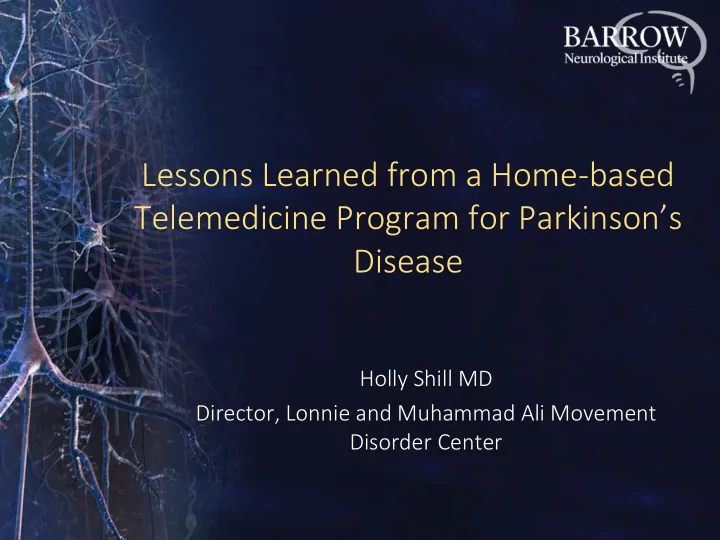

Lessons Learned from a Home-based Telemedicine P rogram for Parkinson’s Disease Holly Shill MD Director, Lonnie and Muhammad Ali Movement Disorder Center
Background • Parkinson’s disease • Course over 10-20 years • Affects mobility, cognition, emotions, autonomic function • 1% of those over age 60 • 7% of those in care facilities • Growing more rapidly than Alzheimer’s disease (AD) • “The emerging evidence for a Parkinson’s disease pandemic” (Dorsey et al, 2018) • Cost of care in more advanced stages greater than AD
Legacy Care A PD palliative care program • Funded by the Bob and Renee Parsons Foundation in 2017 • Entry criteria: • Medicare definition of homebound status • Significant caregiver burden • Components: • Multi-disciplinary care clinic • Home visits for Maricopa County • Telehealth • Caregiver intervention research • Virtual outreach
Rationale for telehealth in PD • PD Medicare patients who don’t see a neurologist: • 14% more likely to fracture hip • 21% more likely to be placed in skilled nursing • 22% more likely to die (Willis, 2011) • PD patients who see movement specialist: • Better adherence to quality indicators (Cheng, 2007) • 78% for MDS vs. 70% neuro vs 52% non -neuro • More satisfied with care (Dorsey, 2010) • Do better in hospital (Aslam, 2019) • In Arizona • Movement specialist in city centers (Phoenix, Tucson) • Preliminary pilot studies show feasibility
Telehealth in 2017 • Email not HIPAA compliant • Access to technology by patients uncertain • Broadband access uncertain • Telehealth largely not covered by insurance • Exception rural patients at Medicare originating sites • Licensing issues for providers
Our model • Provide in-person visits for those in Maricopa County • For all else, telehealth: • Provided tablet with built in cellular card • Software application loaded • 1 click to enter the doctor’s office • Sounds easy, right?
Problems • In first year, only 50% of visits were successful • Charging tablet • Turning on tablet • Not just 1 click, many steps • Patient preparation not happening properly • Modifications made to protocol • Changed vendor for telehealth platform • Nurse contact the day before
The numbers • Year 1 (2017)- 65 people enrolled • 24 home visits, no telehealth • Minimal remote outreach • Year 2 (2018)- 144 Enrolled • 122 home visits, 43 telehealth • 1452 phone calls • 839 individuals access virtual programming • PD All Star conference, PD 101, 202, support groups • Year 3 (2019) • 230 telehealth visits by previous vendor • 15 with new vendor
Impact of COVID-19 • March 17, Medicare announced: • Telehealth new and return patients covered at same rate as in-person visit • Coverage for brief phone call check-ins (G2012) • Coverage for remote evaluation of recorded images/video (G2010) • Coverage of digital visits through portal or secure email (99421-3) • HIPAA privacy rules waived • March 25, Ducey mandated covering telehealth in AZ • March 30, Medicare announced: • Coverage for phone calls up to 30 minutes (99441-3) • Coverage for total time spent in E/M (not MDM driven)
How have we changed? • Switched our platform (yet again) • Now seeing 10-12 virtual patients per day with AV • Team of 24 providing tech support for clinic 1-2 days prior to visit • Medical assistants do their part 15 minutes prior to visit • I spend 15-30 minutes in E/M
3 Week numbers March 21-April 9 • Total clinic visits: 1285 • Movement program: • 324 visits over 10 minutes • 260 visits over 20 minutes • Average “tech check” time=10 minutes • Average MA time about 15 minutes
New issues • About 10-15% refuse telehealth • Will wait for in-person visit • 2 5% don’t “pass” tech check • Outfitting staff with equipment • Space, AV equipment, licenses • Communicating remotely efficiently • Using Jabber for instant messaging • Adding in trainees • Residents, fellows, medical students • How to do visits in facilities?
Lessons learned • Technology needs to be simple • Older population, mobility and cognitive problems • Sending tablets to patients not sustainable • Needs to be email or text • Training on technology required- should not be done by HCP • Broadband and technology access still issue • Patients not that worried about HIPAA • Reimbursement drives utilization • Patient satisfaction appears to be high • Provider satisfaction appears to be high
Recommendations Post COVID-19 • Continue to keep HIPAA relaxed • Consider hybrid model for reimbursement • More than 60 miles away? • Medicare Homebound Status? • Require annual in person visit? • Address remote and underserved areas better • Utilizing community health centers for technology hubs? • Consider simplification of platform options • Multiple providers means multiple platforms
Thank you!
Recommend
More recommend